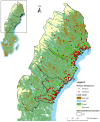Modelling zoonotic diseases in humans: comparison of methods for hantavirus in Sweden
- PMID: 22984887
- PMCID: PMC3517350
- DOI: 10.1186/1476-072X-11-39
Modelling zoonotic diseases in humans: comparison of methods for hantavirus in Sweden
Abstract
Because their distribution usually depends on the presence of more than one species, modelling zoonotic diseases in humans differs from modelling individual species distribution even though the data are similar in nature. Three approaches can be used to model spatial distributions recorded by points: based on presence/absence, presence/available or presence data. Here, we compared one or two of several existing methods for each of these approaches. Human cases of hantavirus infection reported by place of infection between 1991 and 1998 in Sweden were used as a case study. Puumala virus (PUUV), the most common hantavirus in Europe, circulates among bank voles (Myodes glareolus). In northern Sweden, it causes nephropathia epidemica (NE) in humans, a mild form of hemorrhagic fever with renal syndrome.Logistic binomial regression and boosted regression trees were used to model presence and absence data. Presence and available sites (where the disease may occur) were modelled using cross-validated logistic regression. Finally, the ecological niche model MaxEnt, based on presence-only data, was used.In our study, logistic regression had the best predictive power, followed by boosted regression trees, MaxEnt and cross-validated logistic regression. It is also the most statistically reliable but requires absence data. The cross-validated method partly avoids the issue of absence data but requires fastidious calculations. MaxEnt accounts for non-linear responses but the estimators can be complex. The advantages and disadvantages of each method are reviewed.
Figures
Similar articles
-
Nephropathia Epidemica Caused by Puumala Virus in Bank Voles, Scania, Southern Sweden.Emerg Infect Dis. 2024 Apr;30(4):732-737. doi: 10.3201/eid3004.231414. Emerg Infect Dis. 2024. PMID: 38526134 Free PMC article.
-
Population Dynamics of Bank Voles Predicts Human Puumala Hantavirus Risk.Ecohealth. 2019 Sep;16(3):545-557. doi: 10.1007/s10393-019-01424-4. Epub 2019 Jul 15. Ecohealth. 2019. PMID: 31309365 Free PMC article.
-
Spatial prediction and validation of zoonotic hazard through micro-habitat properties: where does Puumala hantavirus hole - up?BMC Infect Dis. 2017 Jul 26;17(1):523. doi: 10.1186/s12879-017-2618-z. BMC Infect Dis. 2017. PMID: 28747170 Free PMC article.
-
Hantavirus infections in Europe.Lancet Infect Dis. 2003 Oct;3(10):653-61. doi: 10.1016/s1473-3099(03)00774-6. Lancet Infect Dis. 2003. PMID: 14522264 Review.
-
Hantavirus Research in Finland: Highlights and Perspectives.Viruses. 2021 Jul 26;13(8):1452. doi: 10.3390/v13081452. Viruses. 2021. PMID: 34452318 Free PMC article. Review.
Cited by
-
How Bank Vole-PUUV Interactions Influence the Eco-Evolutionary Processes Driving Nephropathia Epidemica Epidemiology-An Experimental and Genomic Approach.Pathogens. 2020 Sep 25;9(10):789. doi: 10.3390/pathogens9100789. Pathogens. 2020. PMID: 32993044 Free PMC article.
-
Identifying correlates of Guinea worm (Dracunculus medinensis) infection in domestic dog populations.PLoS Negl Trop Dis. 2020 Sep 14;14(9):e0008620. doi: 10.1371/journal.pntd.0008620. eCollection 2020 Sep. PLoS Negl Trop Dis. 2020. PMID: 32925916 Free PMC article.
-
The Ecology and Phylogeny of Hosts Drive the Enzootic Infection Cycles of Hantaviruses.Viruses. 2019 Jul 23;11(7):671. doi: 10.3390/v11070671. Viruses. 2019. PMID: 31340455 Free PMC article.
-
Spatial dynamics of a zoonotic orthohantavirus disease through heterogenous data on rodents, rodent infections, and human disease.Sci Rep. 2019 Feb 20;9(1):2329. doi: 10.1038/s41598-019-38802-5. Sci Rep. 2019. PMID: 30787344 Free PMC article.
-
Projecting the potential distribution of Rickettsia japonica in China and Asian adjacent regions under climate change using the Maxent model.Front Public Health. 2025 Mar 6;13:1478736. doi: 10.3389/fpubh.2025.1478736. eCollection 2025. Front Public Health. 2025. PMID: 40115352 Free PMC article.
References
-
- Brotons L, Thuiller W, Araujo M, Hirzel A. Presence-absence versus presence-only modelling methods for predicting bird habitat suitability. Ecography. 2004;27:437–448. doi: 10.1111/j.0906-7590.2004.03764.x. - DOI
-
- Lobo J, Jimenez-Valverde A, Hortal J. The uncertain nature of absences and their importance in species distribution modelling. Ecography. 2010;33:103–114. doi: 10.1111/j.1600-0587.2009.06039.x. - DOI
-
- Boyce M, Vernier P, Nielsen S, Schmiegelow F. Evaluating resource selection functions. Ecol Model. 2002;157:281–300. doi: 10.1016/S0304-3800(02)00200-4. - DOI
Publication types
MeSH terms
LinkOut - more resources
Full Text Sources
Medical



